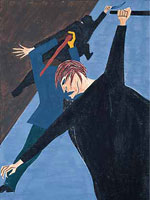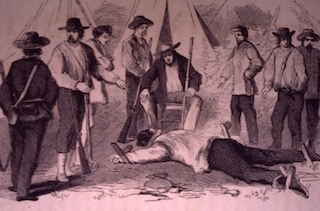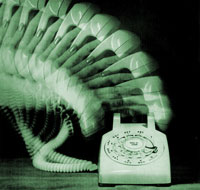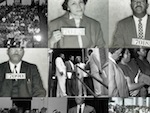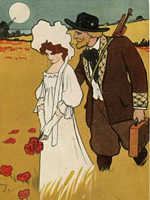Religion and the Civil War: A Guide for Pre-Service Teachers

What is it?
As historian James McPherson has written “Religion was central to the meaning of the Civil War, as the generation that experienced the war tried to understand it.” However, many of the resources available for students learning about the war do not deal with the religious themes of the war and therefore miss important context to one of the most consequential topics in U.S. history.
Key points:
- This activity will take one 90-minute period or two 45-minute periods. It is appropriate for a high school U.S. history classroom, but can be modified for a variety of learners.
- Students will analyze, interpret, and evaluate primary sources.
- Students will learn more about the causes of the Civil War as well as the course and character of the war and its effects on the American people.
Approach the Topic
This guide will use a variety of Library of Congress sources including sheet music from marching songs that soldiers sang as they marched to battle. These songs often contained religious themes that connect to what soldiers viewed as the meaning of the war. Students will also read excerpts from sermons by various religious leaders in the North and the South as they looked to religious texts in an effort to explain the war. The guide will also contain tips for teaching about religion generally to help teachers engage students with what can be a challenging topic to teach.
In introducing this topic to students, emphasize that the United States at the time of the Civil War was a very religious nation. Church attendance was frequent in all regions of the U.S. and significantly Americans on both sides of the war often invoked God and the Bible when justifying the war. According to historian Mark Noll, this took a variety of forms. For example, the Bible was frequently used to both condemn slavery and justify it. Similarly, American Protestants in both the North and South identified strongly with the notion of divine providence, that is, the idea that God was actively working to shape events and this work could be perceived by people as the events happened. However, which events to cite and how to interpret them differed greatly depending on which side of the conflict a person supported. In this activity students will examine primary sources to note how Americans invoked religion during the Civil War and how understanding the role of religion changes our understanding of the war.
Description
This activity facilitates students as they engage with primary sources and understand better how religion shaped the beliefs of Americans during the Civil War. Students will examine sources carefully, note details, and then interpret what the details might mean based on what they know and their interpretations of the other sources. Working in groups, students will use these interpretations to create a museum exhibit (either physical or digital) to communicate the role of religion in the Civil War.
Teacher Preparation
Make the primary sources below available to students either through links, if using electronic devices, or by printing them out. According to your students’ needs, you may need to guide students to the relevant excerpts or share the excerpts separately. These excerpts are included below.
Prepare the necessary materials for students to create their exhibit. If it’s a physical exhibit this could be as simple as scissors to cut out excerpts from primary sources and materials to create captions or annotations for those sources. Poster board can also be used if the exhibits are to be more permanent or for display in another part of the school.
For digital exhibits, a variety of formats might be used including PowerPoint, Google Slides, Google Sites, Canva, or Omeka There are all free to use or have free versions for teachers and students.
Differentiation note: Depending on students reading abilities, teachers may want to consider accommodations for engaging with the primary sources below. Excerpts from text sources have been included along with annotations to highlight the most relevant passages. Teachers may also elect to read excerpts out loud to students or to assign smaller chunks of texts for students to examine in small groups.
Primary sources
J.H. “A prophecy of the Southern Confederacy” Jefferson County, Virginia [1862?].
Excerpt(s):
That God should love thee, has been demonstrated in favour of the South, with the abundant crop, supplies and comforts to support the Armies with the material of war, is strongly shewing I have loved thee, and the men for thee. Isaiah 43d chapter 14th verse is England, with Europe, now acting in behalf of the South, by the receiving of our Commissioners or Ministers. The result of that act alone will stay the Northern power from continued aggression—thereby “giving a people for thy life.” After this promise, hear the 5th verse: “Fear not: for I am with thee: I will bring thy seed from the east, and gather thee from the west.”
Annotation: White American Protestants, both in the North and South, strongly believed in divine providence — that God was actively working to shape events and that God’s efforts could be perceived as these events were happening. This source from Jefferson County (part of West Virginia today) in 1862 is an example of this thinking. Presenting itself as a “prophecy,” it predicts that the Confederacy will achieve victory over the Union because God’s love “has been demonstrated in favour of the South.” Further signs that the Confederacy will win, according to this author, are seen in the “abundant crop, supplies and comforts to support the Armies with the material of war”. The “prophecy” goes on to predict that England will side with the Confederacy against the Union and bring about an end to the war. Given the estimated year, 1862, which was early in the war, the source is likely a reaction to the success Confederate armies were having against Union forces at that point in the war.
A sermon on the war, by the Rev. Elias Nason, preached to the soldiers at Exeter. N. H. May 19, 1861.
https://www.loc.gov/item/rbpe.09400400/
Excerpt(s):
My hope of ultimate success does not so much repose in our superiority to our enemies in point of military skill, or power, as in our going forth to the field of contest in confederation with Almighty God. . .
Why then am I hopeful in this dreadful conflict? I answer fairly: not so much because of our numbers, gold, or fleets, or generalship at the north; not so much because of our union at the north; not so much because of our “materiel;” our “sinews of war” at the North—No, no, no! not these alone.—but I am confident of final victory because of the plans and the action of that wise Spirit whom we come into this temple to worship today; because we have set up our banners, not in our own, but in his Almighty name; and because I believe we go forth under his benediction to the battlefield—and one with God upon his side is an invincible legion. The South has set up its banner in the name of secession, in the name of rebellion; in the name of oppression! The poisonous rattlesnake is its fitting emblem. Such a banner ought to fall; it is opposed to human progress; learning, liberty; it is opposed to the great leading ideas of the nineteenth century; such a banner ought to fall; and I feel assured that God through your right arm intends to make it fall; and the illustrious “Star spangled banner” rise, heaven-lighted with the swelling songs of Freedom, over it.
Annotation: The notion of divine providence, that God would actively shape events in favor of the American people, was just as strongly held in the North as in the South. Here a sermon by Reverend Elias Nason, delivered to Union troops in New Hampshire, expresses faith that the Union will defeat the Confederacy because God will be on their side. “I am confident of final victory because of the plans and the action of that wise Spirit whom we come into this temple to worship today.” Nason also declares the Union on the side of “freedom” as well as “human progress; learning, liberty” likely references to fighting against slavery. To Eason this was further evidence that God was on the Union side. Note too the month and date of the sermon, May of 1861, was a month after the Confederate attack on Fort Sumter and still a few months before the first major battle of the war. At this point many on both sides would have predicted a short victorious war.
“The Nutshell: the system of American slavery "tested by Scripture," being "a short method" with pro-slavery D.D.'s, whether doctors of divinity, or of democracy, embracing axioms of social, civil, and political economy, as divinely impressed upon the human conscience and set forth in divine revelation; in two lectures,” 1862
https://www.loc.gov/item/12005595/
Excerpt(s):
[From page 22-23]
And yet will ye plead the Scriptures in justification of American Slavery? We can imagine but one mode of evading the common sense application of the “Golden Rule.” It is substantially this: “With my present experience and knowledge,” says the apologist, “of the conditions of mankind, were I a black man,I would prefer for myself and posterity forever the condition of Slavery to that of Freedom. So do I unto others as I would they should do unto me.” Dare ye answer thus at the bar of God in the day of final account! at His bar who commands: “Break every yoke and let the oppressed go free”!
Annotation: Slavery was the central issue dividing the Union and Confederacy and on this issue too both sides believed that the Bible supported their position. While pro-slavery Christians pointed to the existence of slavery in the Old Testament of the Bible, anti-slavery Christians tended to argue that the teaching of the New Testament were opposed slavery as it was practiced in the United States. In this 1862 pamphlet, the author identified only as “Layman of the Protestant Episcopal Church in the Diocese of Connecticut” argues that the Golden Rule, found in the book of Matthew and Luke as part of the Sermon on the Mount, necessarily means that slavery is not justified. The author then quotes from the book of Isaiah, ““Break every yoke and let the oppressed go free” a passage often invoked by abolitionists.
Battle hymn of the Republic / by Mrs. Julia Ward Howe. [Philadelphia] : Published by the Supervisory Committee for Recruiting Colored Regiments, [1863?]
https://www.loc.gov/item/98101743/
Battle hymn of the republic - background information
https://www.loc.gov/item/ihas.200000003/
Battle hymn of the republic audio
https://www.loc.gov/item/ihas.100010455/
Song of the first of Arkansas ... written by Captain Lindley Miller, of the First Arkansas Colored Regiment
https://www.loc.gov/item/amss.cw105500/
Excerpt(s):
Oh, we're the bully soldiers of the “First of Arkansas,”
We are fighting for the Union, we are fighting for the law,
We can hit a Rebel further than a white man ever saw,
As we go marching on.
Chorus: Glory, glory hallelujah.
Glory, glory hallelujah.
Glory, glory hallelujah.
As we go marching on.
2. See, there above the center, where the flag is waving bright,
We are going out of slavery; we're bound for freedom's light;
We mean to show Jeff Davis how the Africans can fight,
As we go marching on!
(Chorus)
3. We have done with hoeing cotton, we have done with hoeing corn,
We are colored Yankee soldiers, now, as sure as you are born;
When the masters hear us yelling,
they'll think it's Gabriel's horn,
As we go marching on.
(Chorus)
4. They will have to pay us wages, the wages of their sin,
They will have to bow their foreheads to their colored kith and kin,
They will have to give us house-room, or the roof shall tumble in!
As we go marching on.
(Chorus)
5. We heard the Proclamation, master hush it as he will,
The bird he sing it to us, hoppin' on the cotton hill,
And the possum up the gum tree, he couldn't keep it still,
As he went climbing on.
(Chorus)
6. They said, “Now colored brethren, you shall be forever free,
From the first of January, Eighteen hundred sixty-three.”
We heard it in the river going rushing to the sea,
As it went sounding on.
(Chorus)
7. Father Abraham has spoken and the message has been sent,
The prison doors he opened, and out the pris'ners went,
To join the sable army of “African descent,”
As we go marching on.
(Chorus)
8. Then fall in, colored brethren, you'd better do it soon,
Don't you hear the drum a-beating the Yankee Doodle tune?
We are with you now this morning, we'll be far away at noon,
As we go marching on. (Chorus)
Annotation: The United States at the time of the Civil War was a very religious nation and soldiers in the Civil War often expressed their understanding of the war in religious terms. This can be seen in the marching songs that were used to recruit soldiers to the war and that were later sung by the soldiers themselves to keep time during marches and engage soldiers’ interest. A famous example of a marching song, “The Battle Hymn of the Republic”, incorporates religious themes implying that God is on the side of the Union in their effort to defeat the Confederacy and end slavery. Many versions of this song with different lyrics were sung by Union troops including “Song of the first of Arkansas”, the first of Arkansas being a regiment of Black soldiers. In addition to the “Glory, glory hallelujah” chorus, the song references Gabriel’s Horn which in many Christian traditions signals that Judgment Day has arrived. In the song, when the “masters” hear the first Arkansas coming they will think it’s Gabriel’s Horn.
In the Classroom
Warm up (5 minutes)
When teaching the history of religion it is important to communicate to students that they are learning about religion to better understand people who lived in the past. Thus the goal is not to judge the validity of those beliefs or to accept or reject them. To set the stage, begin by posting the quote above by historian James McPherson and then asking students how historians might come to this conclusion that religion was important to Americans during the Civil War. “What kinds of evidence do you think historians might use to come to this conclusion?” Answers can be written on the board. The purpose of the warm up is to remind students that their goal is to try to understand these beliefs, not assess the accuracy or legitimacy of these beliefs. Inform students that the goal of the activity is to better understand what role religion played in the Civil War.
Step One: (20 minutes)
Place students in groups. Each group member receives the same primary source and each group receives a different primary source. This is a jig-saw group activity so students will join new groups to create their exhibits. In their primary source groups, direct students to examine the source carefully noting all the words that might relate to religion. Students should also note the date of the source, who created the source, and who they think the audience might be. They can either jot these down as notes or if more scaffolding is needed, students may complete a primary source analysis sheet for their source.
Step Two (40 minutes)
Place students in new groups such that each group has a member with a different primary source. Instruct students that each group will be responsible for creating a museum exhibit on the topic of religion and the Civil War. Each exhibit will feature
- The primary sources the students analyzed
- Captions for each source of about 50 words explaining what the source is and what it tells us about religion in the Civil War.
- A paragraph introducing the exhibit.
- A title for the exhibit (Note: Exhibit titles are often phrases from one of the sources used in the exhibit).
Again this exhibit could be designed as a physical exhibit or a digital exhibit using the tools mentioned above.
Step 3 (25 minutes)
Students group share exhibits with class. This can either be done with each group presenting to the class or using a “gallery walk” where half the students’ exhibits are on display with their creators there to explain and answer questions while the other half of the class walk around to view the exhibits. Halfway through this period the groups switch places.
General Tips for Teaching Controversial Subjects
Teaching history inevitably means teaching about topics that generate strong reactions from a wide range of people. While not every reaction can be anticipated, the following tips can provide a strong basis for a rationale for your learning activities:
- Center activities on primary sources. Primary sources are tangible evidence that allow students to engage directly with history. These primary sources in particular were preserved and digitized by the Library of Congress because they were deemed important to the history of the United States.
- Discussion and analysis of these sources can be wide ranging, but within each class those discussions can always be turned back to the source itself.
- The sources are also, by definition, only pieces of a puzzle. They bring us closer to understanding the past but there is always room for doubt and uncertainty.
- Questions, Observations, and Reflections should come from students. These are primarily student-directed learning activities. It is the instructor's role to create a space for inquiry and empower students to drive the inquiry.
- Linking to state or national standards can provide support and justification for classroom activities such as these. The Civil War is explicitly mentioned in many state standards for example. The activities in this guide also link to NCSS Themes including Theme 1: Culture ("How do various aspects of culture such as belief systems, religious faith, or political ideals, influence other parts of a culture such as its institutions or literature, music, and art?") and Theme 2: Time, Continuity, and Change ("How do we learn about the past? How can we evaluate the usefulness and degree of reliability of different historical sources?")
